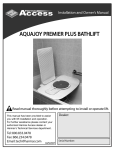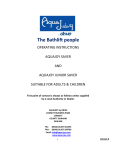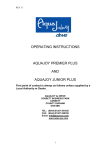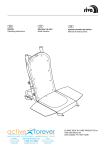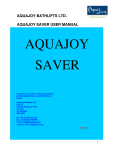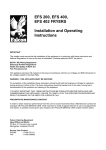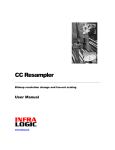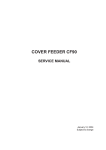Download USER MANUAL Moulder MO-300
Transcript
USER MANUAL Moulder MO-300 Glimek AB 407326-11 Box 124, S-28064 Glimåkra Sweden Tel. 044-44 900, Int 0046-44 44 900 Fax. 044-44 910, Int 0046-44 44 910 FOREWORD CONTENTS We should like to congratulate you on your purchase of a first class moulder. Manufactured by Glimek AB. The machine has been developed so as to be simple to use, maintain and service. To obtain the maximum performance from the machine it is important that it is used correctly and that the instructions in the User Manual are followed. The User Manual describes the operations and adjustments that the user can and should carry out so that the machine can be used to the best advantage. The operator is expected to have a degree of experience in the use of baking machinery. Keep this manual to hand for when needed. Funktions Technical description Delivery check Installation Controls Before operating Operating Warning/Instructional signs Post operation Maintenance Checks and adjustments Specification 2 2 3 4 5 7 7 8 9 12 14 16 Appendix INTENDED USES The machine is intended to be used when shaping pieces of dough to their proper shape. GENERAL SAFETY INSTRUCTIONS This machine is constructed and built to be operated safely by both the user and operator. A variety of protective and safety devices have been built into this machine. It is unsafe to operate this machine without these safety devices both in place and properly functioning. It is a violation of the accepted safety standards to bypass the recommended safety features. It is recommended that the end user of this machine maintains the posted safety instructions, caution labels and warning labels for the life of the machine. This maintenance includes but is not limited to the legibility and placement of these instructions, caution and warning labels. Cleaning of this machine should be done under all applicable lock-out / tag-out procedures and failure to do so could result in personal injury and / or property damage. It is strongly recommended that the user and operator become familiar with all the functions of this machine and the handling of this machine by a thorough rewiew of this user manual, the instructions and the warnings contained in this user manual and on the machine. Only GLIMEK original parts should be used in the repairs of this machine so as to maintain the quality of operation as intended. Violations of the standards and operation procedures may be cause for the manufacturer to void any warranty. In addition, the user shall assume all risks for damages to persons and / or property arising out of the violation of any safety standards, violation of the recommended operation procedures and damages to persons and property which may result from any and all unauthorized changes or modifications to this machine. THINK SAFETY. 1 FUNCTIONS & TECHNICAL DESCRIPTION D z C z E F G H I J z z B A z z z z z z z M N Side view from the right A B C D E = = = = = Drive motor/gear Driv. roller(conv.belt) Hopper Cover for hopper Rolling unit F G H I J = = = = = Conveyor belt Pressure board Lateral lining Drum Collection tray O Inset picture, crosssection, rolling unit M = Upper pair of rollers N = Lower pair of rollers O = Chain drag The piece of dough falls down through the protective hood (D) between the side flaps of the hopper(C). The distance between these can be adjusted using a handle on either side; the position is indicated by a pointer. Further down to the upper pair of rollers (M). The rolling out continues in the lower pair of rollers (N) whereupon the piece of dough descends to the conveyor belt (F) and is carried along under the chain drag (O) where the piece of dough is shaped into a roll. The conveyor belt transports the dough roll under pressure board (G) and between the lateral linings (H) where the final length and diameter of the piece of dough are determined. The prepared piece of dough is delivered to the collection tray (J). TECHNICAL DESCRIPTION The moulder is driven by a geared motor. From the motor the power goes via a duplex chain in the right-hand rear leg, to the driving rollers of the conveyor belt and from there via a chain to the drive of the rolling unit. The centre chain of the rolling unit drive and the chain, driving the four dough rollers, are provided with automatic chain tensioners, so that smooth and safe running can be maintained. The dough rollers are manufactured from polyethylene and each one has a spring-loaded scraper. The distance between the dough rollers is set by means of a handle for each pair of rollers. The tension of the conveyor belt can be adjusted by the belt drum with a screw on each side. The driving roller can be adjusted on the right hand side in order to guide the path of the belt. cont. 2 TECHNICAL DESCRIPTION cont. DELIVERY CHECK The input side of the chain drag is fixed in a square section axle which is situated in a holder on each side of the conveyer belt and can be placed at three different heights above the belt. Standard lateral linings The lateral linings are fixed in two graduated axles and can be set separately at the inlet- and exit ends. Parallel adjustable lateral linings (alternative) Left and right end rollers are fixed on two rotational axles and can be set simultaneously using the handle. They can be set separately at the infeed and outfeed ends. The end rollers can be maneuvered from either side of the machine by adjusting the handles and hoods. The pressure board hangs on two hinges and can be fold up to facilitate cleaning. The height above the belt can be set separately at the inlet- and exit ends by means of two graduated adjusting handles. The height of the pressure board can be maneuvered from either side by turning the setting knob. The collection tray can be placed in two different positions. POST DELIVERY CHECK The machine has been thoroughly checked, tested and test operated before it left the manufacturer so that the equipment, operation and finish shall meet the high standards demanded. Damage can occur during transportation so we ask you therefore to make a post delivery check in accordance with the following: Inspect the packaging and the machine for mechanical damage. If damage has occurred, please contact the transport company. Included with the machine: A collecting tray and a carton, banded to the top of the pressure board. In the carton, the following are included: 4 off Castors 16 off Screws 16 off Plain washers User manual Documents 3 INSTALLATION Setting castors in position Lift up the back and front ends of the long moulder with for example a pallet hoist. Take care with the back end so that no electrical cables are caught up. Put the castors in place and the four screws per wheel. Place the machine in position and secure it there by locking all four wheels. Put the collection tray in place. Check the plate on the machine before connecting to the electrical supply, to ensure that the voltage is suitable. Ensure that the safety systems are operational and that no foreign substances are in or on the machine. Ô Correct direction of rotation Start the machine for a short while. Check that the conveyor belt goes in the right direction. Contact an electrician if the machine is rotating in the wrong direction. 4 CONTROLS Start and stop buttons The startbutton, 1 is green. The stop button, 0 is red. Setting of the sideflaps of the hopper Ô Ô 2 1 A handle is positioned on both sides for centering the side flaps so that the pieces of dough fall down centered between of the rollers. The dough can be rolled out evenly on both sides. Turn handle 1 inwards or outwards from either side. The position set is indicated by a pointer 2. Ô 1 Setting of upper and lower pair of rollers The adjusting handle has a scale from 0 - 20, which shows the relative distance between the pair of rollers. Press on the centre of the handle and pull out the handle when resetting. The adjusting handle for the pair of rollers can be positioned on either side of the machine. See page 14 for how to transfer. Setting of chain drag Ñ Lift up the front protective cover. The chain drag inlet end can be set to three different heights and positions in relation to the conveyor belt. Pull out the locking pin, (by the arrow) on both sides and place the axle of the chain drag in the same groove on both sides. The rolled dough should come in easily under the chain drag but not too near the roller. cont 5 CONTROLS, cont. Setting of the inlet- and the exit height of the pressure board The adjusting handle has a scale from 0 - 60 which shows the relative distance to the conveyor belt. The pressure board can be adjusted to different heights in each respective end. Generally the exit height should be greater than the inlet height. The adjusting handles for the pressure board can be situated on either side of the machine. See page 14 for how to transfer. Ð Setting of the standard lateral linings The lateral linings on both sides are supplied with graduated rulers for setting of the distance between the lateral linings. The distance between the markings is 10 mm. Dist. betw. lateral linings Setting Min. 100 mm 10 Max. 660 mm 66 The lateral linings should be adjusted to the same distance on both sides and should be parallel. Altering of a marking on the rulers changes the distance between the lateral linings by 20 mm i.e. 10 mm on each side. Setting parallel adjustable lateral linings End rollers on both sides are set simultaneously using a handle. The distance between the markings is 10 mm. Dist. betw. lateral linings Setting Min. 100 mm 10 Max. 660 mm 66 Changing a marking on the graduated ruler will change the distance between the lateral linings by 20 mm, 10 mm on each side. They can be set separately at the infeed and outfeed ends 6 BEFORE OPERATING Cleaning of the machine Wipe the whole machine with drying paper. Especially important are the components which come in contact with the dough. Whenever the machine is cleaned the power should be disconnected. The plug should be pulled out, or when a fixed connection is used the main power switch should be turned off. Adjust the rollers, the chain drag, the pressure board and the lateral linings. (See recommendations below). Start the machine and run some pieces of dough through the machine a few times until they are no longer contaminated by the machine. Ô OPERATING The incoming size of the dough as well as the finished dimensions should serve as a guide when it comes to the settings on the machine. It is also important that the reshaping of the dough is done in gradual stages. The weight of the pieces of dough is the criteria which decides the setting of the machine in the initial starting phase, but the final adjustments can be made when the end result is seen. The suggestions below can serve as inlet values: Weight of dough Length 450 gr 230 mm A= 11, B= 7, C= 17, D= 30 Lateral linings set to 23. A B C D Weight of dough Length 800 gr 250 mm A= 12, B= 8, C= 19, D= 36 Lateral linings set to 25. The chain drag is usually in the lowest position. cont A = Upper pair of rollers B = Lower pair of rollers C = Pressure board, in D = Pressure board, out 7 OPERATING, cont. Run some pieces of dough through the machine and check at the collecting tray that the shape and appearance is correct. Ô Ó Check continually during running that the pieces of dough have the correct shape and appearance. WARNING AND INSTRUCTIONAL SIGNS Warning and/or instructional signs are affixed to the machine to warn against incorrect actions when operating the machine and to make the operating easier. Always follow the directions on these signs and urge all personnel in proximity to the machine to do the same. N.B. It is the responsibility of the owner/user to see to it that warning and instructional signs are in place and legible. 8 POST OPERATION daily Whenever the machine is being cleaned it should be stationary and the main power turned off; the plug should be pulled out if no other direction are given. Cleaning of hopper/cover for hopper Pull the cover forward. Scrape clean inside the hopper and on the cover with a plastic scraper. Wipe with drying paper afterwards. Push the cover back. Cleaning of the rollers Open the front protective cover and clean with a brush around the scrapers. Cleaning of the chain drag Ñ Push up the front protective cover. Remove the locking pins. cont 9 POST OPERATION, daily, cont. Cleaning of the chain drag cont. Lift up the chain drag. Clean it in lukewarm water, dry it and replace it in reverse order. Cleaning of the pressure board and the lateral linings Extract the locking pins for the pressure board. Ð Raise the pressure board and place support pin in the locking lug. Í Clean the pressure board with a plastic scraper. Brush off the pressure board with a soft brush. Scrape away any remnants of dough from the lateral linings and wipe with a damp cloth. 10 POST OPERATION, daily, cont. Cleaning of the conveyor belt. When cleaning the conveyor belt the machine must be running. Ensure that no unauthorized persons are in the vicinity. Start the machine and hold a plastic scraper against the belt (see diagram) until any remnants of dough are removed. Brush off the belt with a soft brush. Lower the pressure board. Ï 11 MAINTENANCE EVERY THIRD MONTH To tension the duplex chain Loosen and remove the protective cover at the rear of the machine. Loosen and remove the chain guard. The tension of the chain is correct if the chain can be moved approx. 10 mm in the middle between the chain sprockets (see arrows). When needed, brush the chain with oil. Î Í Ó Ô The tension of the chain is adjusted by raising/ lowering the motor. Loosen the four mounting bolts, (see arrows); two are situated on the front and adjusted with the adjusting screw which is situated in the beam in the centre under the gear. Lock the adjusting screw with the locking nut after finishing the adjustment. N.B. Take care that the motor is horizontal after adjustment and pull the four mounting bolts tight. Reassemble the parts in reverse order. 12 MAINTENANCE, cont. EVERY THIRD MONTH, cont. Oiling the gears Loosen and remove the protective cover at the back of the machine. See page 12. The oil level is checked by loosening the level plug. The level should be exactly at the holes lower edge. Filling of the oil is facilitated by using the filling plug (see white arrow). An oil exchange using mineral oil must be done after 10,000 hours of operation. Greasing the middle chain and the roller chain When needed remove the adjusting handles (see page 14). Loosen and remove the side cover. The middle chain and the drive chain for the rolling mill should be brushed with oil when needed. 13 Ï CHECKS AND ADJUSTMENTS Transferring the control handles Loosen the lateral linings on both sides, in four places. Pull out the lateral linings to their outermost positions on each side. Lower the pressure board so that it is positioned directly on the conveyor belt. The handle is now towards the zero (see arrow). Loosen the centre pin with an "Allen key" and pull out the handle. Í Loosen the screws, (see arrows), which hold the hub and the drivingpin with an "Allen key". Ð Ò Ñ Loosen the hub and the drivingpin and place it on the other side. Fit the driving pin into the slot of the axle. Fasten the screws. Í Put the handle in place with the marking on the handle toward the zero on the scale, (see arrow). Pull the handle tight with the centre pin using an "Allen key". Readjust the pressure board and the lateral linings. cont. 14 CHECKS AND ADJUSTMENTS, cont. The belt of the conveyor The tension of the belt is adjusted by tensioning or loosening the adjusting screws on both sides. Adjust the tension of the belt so that it is on the middle of the drum. If the belt is not running properly in the middle of the driving roller, then the position of the roller should be adjusted backwards/forwards. This adjustment is done at the left side of the machine. First loosen the nuts on the bearing holder. Tighten or loosen the adjusting screw's cap nut (see arrow) until the belt is running properly in the middle of the driving roller. Finally retighten the nuts. Motor protector and control fuse As protection against overload a motor protector and a control fuse are built-in. They are situated in the electrical box by the left rear leg of the machine. Ó Ô N.B. They should normally not be activated and if it happens several times then the reason must be determined. The control fuse The control fuse is an automatic fuse, which protects the control system of the machine. Loosen and remove the protective cover. Loosen the four retaining screws and remove the lid of the electrical box. Ó Ô If the control fuse has been activated, the rocking commutator points to the right (OFF). Reset the fuse by pushing the rocker to the left (ON). Upper arrow. Ð Ï The motor protector If the motor protector has tripped: reset by pushing in the black button. Lower arrow. 15 SPECIFICATION Weight: Electrical supply: Electrical motor: Noise level: Gear wheel oil: Chain oil: 385 kg 3-phase AC 1,1 kW 72 dBA Loadway EP 220 Klüber oil 4UH 1500 or the equivalent Take a note of the machine's serial number and other information. Serial no............................................. Delivery date....................................... Supplier................................................................................................................................ .................................................................................................................................. 16 APPENDIX 2 Sample table where different dough types, recipes and weights and equivalent settings can be noted to simplify settings when later production is current. Dough type Recipe Dough weight Rollers upper/ Pr. board intake/ Lateral lining exit lower 17




















